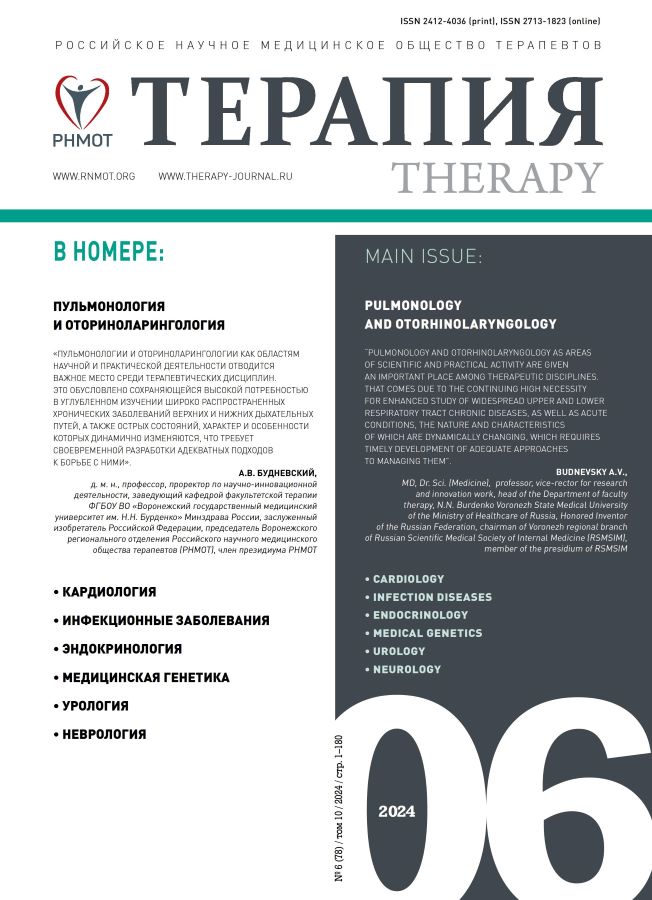Гипокалиемия у пациента с сердечной недостаточностью и фибрилляцией предсердий как предиктор жизнеугрожающей аритмии
- Авторы: Татаринцева З.Г.1,2, Катушкина Ю.А.1,2, Космачева Е.Д.1,2, Бабичева О.В.1,2
-
Учреждения:
- ГБУЗ «Научно-исследовательский институт – Краевая клиническая больница № 1 им. профессора С.В. Очаповского» минздрава Краснодарского края
- ФГБОУ ВО «Кубанский государственный медицинский университет» Минздрава России
- Выпуск: Том 10, № 6 (2024)
- Страницы: 122-128
- Раздел: КЛИНИЧЕСКИЕ СЛУЧАИ
- Статья опубликована: 23.09.2024
- URL: https://journals.eco-vector.com/2412-4036/article/view/636381
- DOI: https://doi.org/10.18565/therapy.2024.6.122-128
- ID: 636381
Цитировать
Полный текст
Аннотация
У пациентов с сердечной недостаточностью (СН) наиболее распространенной аритмией является фибрилляция предсердий (ФП). Все больше данных указывает на связь между гипокалиемией и ФП. В представленном клиническом случае демонстрируется одно из жизнеугрожающих осложнений гипокалиемии у пациента с СН и ФП – развитие фибрилляции желудочков, которая была успешно купирована электроимпульсной терапией и не рецидивировала на фоне антиаритмической терапии и коррекции гипокалиемии. Низкий уровень калия можно устранить с помощью титрования антагонистов минералокортикоидных рецепторов. Кроме того, для повышения уровня К+ в тканях целесообразен прием препаратов, содержащих повышенные дозы калия и магния аспарагината. Данный клинический пример подчеркивает решающее значение адекватной медикаментозной терапии для предотвращения таких жизнеугрожающих осложнений, как фибрилляция желудочков.
Полный текст
Об авторах
Зоя Геннадьевна Татаринцева
ГБУЗ «Научно-исследовательский институт – Краевая клиническая больница № 1 им. профессора С.В. Очаповского» минздрава Краснодарского края; ФГБОУ ВО «Кубанский государственный медицинский университет» Минздрава России
Автор, ответственный за переписку.
Email: z.tatarintseva@list.ru
ORCID iD: 0000-0002-3868-8061
к. м. н., заведующая кардиологическим отделением; ассистент кафедры кардиохирургии и кардиологии факультета повышения квалификации и профессиональной переподготовки специалистов
Россия, Краснодар; КраснодарЮлия Александровна Катушкина
ГБУЗ «Научно-исследовательский институт – Краевая клиническая больница № 1 им. профессора С.В. Очаповского» минздрава Краснодарского края; ФГБОУ ВО «Кубанский государственный медицинский университет» Минздрава России
Email: ukadoc@gmail.com
ORCID iD: 0009-0009-7334-9928
врач-эндокринолог эндокринологического отделения; ассистент кафедры терапии № 1 факультета повышения квалификации и профессиональной переподготовки специалистов
Россия, Краснодар; КраснодарЕлена Дмитриевна Космачева
ГБУЗ «Научно-исследовательский институт – Краевая клиническая больница № 1 им. профессора С.В. Очаповского» минздрава Краснодарского края; ФГБОУ ВО «Кубанский государственный медицинский университет» Минздрава России
Email: kosmachova_h@mail.ru
ORCID iD: 0000-0001-5690-2482
заместитель главного врача по лечебной части; д. м. н., профессор, заведующая кафедрой терапии № 1 факультета повышения квалификации и профессиональной переподготовки специалистов
Россия, Краснодар; КраснодарОльга Васильевна Бабичева
ГБУЗ «Научно-исследовательский институт – Краевая клиническая больница № 1 им. профессора С.В. Очаповского» минздрава Краснодарского края; ФГБОУ ВО «Кубанский государственный медицинский университет» Минздрава России
Email: babolga@mail.ru
ORCID iD: 0000-0003-3010-492X
к. м. н., врач-кардиолог; доцент кафедры кардиохирургии и кардиологии факультета повышения квалификации и профессиональной переподготовки специалистов
Россия, Краснодар; КраснодарСписок литературы
- Packer M., Anker S.D., Butler J. et al.; EMPEROR-Reduced Trial Investigators. Cardiovascular and renal outcomes with empagliflozin in heart failure. N Engl J Med. 2020; 383(15): 1413–24. https://doi.org/10.1056/NEJMoa2022190. PMID: 32865377.
- McMurray J.J.V., Packer M., Desai A.S. et al.; PARADIGM-HF Investigators and Committees. Angiotensin-neprilysin inhibition versus enalapril in heart failure. N Engl J Med. 2014; 371(11): 993–1004. https://doi.org/10.1056/NEJMoa1409077. PMID: 25176015.
- Reddy Y.N.V., Obokata M., Verbrugge F.H. et al. Atrial dysfunction in patients with heart failure with preserved ejection fraction and atrial fibrillation. J Am Coll Cardiol. 2020; 76(9): 1051–64. https://doi.org/10.1016/j.jacc.2020.07.009. PMID: 32854840. PMCID: PMC7455760.
- Wu Y., Kong X.-J., Ji Y.Y. et al. Serum electrolyte concentrations and risk of atrial fibrillation: An observational and mendelian randomization study. BMC Genomics. 2024; 25(1): 280. https://doi.org/10.1186/s12864-024-10197-2. PMID: 38493091. PMCID: PMC10944597.
- Fargaly H., Schultz R.J., Chung U.Y., Rossi N.F. Hypokalemia-induced life-threatening arrhythmia in a patient with congestive heart failure. Cureus. 2023; 15(2): e34971. https://doi.org/10.7759/cureus.34971. PMID: 36938242. PMCID: PMC10019554.
- Savarese G., Xu H., Trevisan M. et al. Incidence, predictors, and outcome associations of dyskalemia in heart failure with preserved, mid-range, and reduced ejection fraction. JACC Heart Fail. 2019; 7(1): 65–76. https://doi.org/10.1016/j.jchf.2018.10.003. PMID: 30553905.
- Ferreira J.P., Butler J., Rossignol P. et al. Abnormalities of potassium in heart failure: JACC state-of-the-art review. J Am Coll Cardiol. 2020; 75(22): 2836–50. https://doi.org/10.1016/j.jacc.2020.04.021. PMID: 32498812.
- Skogestad J., Aronsen J.M. Hypokalemia-induced arrhythmias and heart failure: New insights and implications for therapy. Front Physiol. 2018; 9: 1500. https://doi.org/10.3389/fphys.2018.01500. PMID: 30464746. PMCID: PMC6234658.
- Aronsen J.M., Skogestad J., Lewalle A. et al. Hypokalaemia induces Ca2+ overload and Ca2+ waves in ventricular myocytes by reducing Na+, K+-ATPase α2 activity. J Physiol. 2015; 593(6): 1509–21. https://doi.org/10.1113/jphysiol.2014.279893. PMID: 25772299. PMCID: PMC4376427.
- Wang X.-D., Wang Y., Liu J. et al. Prognosis of older adult patients suffering from atrial fibrillation and hypokalemia. Clin Interv Aging. 2023; 18: 1363–71. https://doi.org/10.2147/CIA.S422801. PMID: 37609041. PMCID: PMC10441655.
- Guzel T., Kıs M., Senoz O. The correlation between the left atrial volume index and atrial fibrillation development in heart failure with mildly reduced ejection fraction and long-term follow-up results. Acta Cardiol. 2022; 77(7): 647–54. https://doi.org/10.1080/00015385.20222.2067674. PMID: 35466864.
- Chung M.K., Refaat M., Shen W.-K. et al.; ACC Electrophysiology Section Leadership Council. Atrial fibrillation: JACC Council Perspectives. J Am Coll Cardiol. 2020; 75(14): 1689–713. https://doi.org/10.1016/j.jacc.2020.02.025. PMID: 32273035.
- Cunningham J.W., Mehra M.R. Hypokalemia in heart failure: A low or a high point? Eur J Prev Cardiol. 2021; 28(3): 313–15. https://doi.org/10.1177/2047487320914745. PMID: 33611466.
- Alvarez C.K., Cronin E., Baker W.L., Kluger J. Heart failure as a substrate and trigger for ventricular tachycardia. J Interv Card Electrophysiol. 2019; 56(3): 229–47. https://doi.org/10.1007/s10840-019-00623-x. PMID: 31598875.
- Государственный реестр лекарственных средств Минздрава России. Инструкции по медицинскому применению лекарственных препаратов с МНН калия аспарагинат + магния аспарагинат. Доступ: https://grls.rosminzdrav.ru/GRLS.aspx?RegNumber=&MnnR=Калия+аспарагинат%2bМагния+аспарагинат&lf=&TradeNmR=&OwnerName=&MnfOrg=&MnfOrgCountry=&isfs=0®type=1%2c6&pageSize=10&token=429c9023-dd79-4811-aa14-13d2e7ed8379&order=Registered&orderType=desc&pageNum=1 (дата обращения – 20.08.2024). [State Register of Medicines of the Ministry of Healthcare of Russia. Instructions for medical use of the medicinal products with INN potassium aspartate + magnesium aspartate. Registration certificate: ЛП-№(000178)-(РГ-RU). URL: https://grls.rosminzdrav.ru/GRLS.aspx?RegNumber=&MnnR=Калия+аспарагинат%2bМагния+аспарагинат&lf=&TradeNmR=&OwnerName=&MnfOrg=&MnfOrgCountry=&isfs=0®type=1%2c6&pageSize=10&token=429c9023-dd79-4811-aa14-13d2e7ed8379&order=Registered&orderType=desc&pageNum=1 (date of access – 20.08.2024) (In Russ.)].










